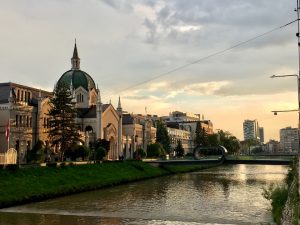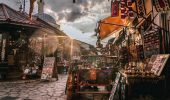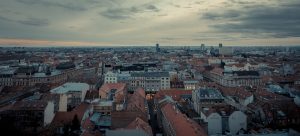
 See some of the most beautiful cities in the Balkans in an 8-day tour of Croatia and Bosnia – as well as some of the natural wonders which the Balkans are best known for, in the rivers, lakes and national parks of Plitvice and the countryside.
See some of the most beautiful cities in the Balkans in an 8-day tour of Croatia and Bosnia – as well as some of the natural wonders which the Balkans are best known for, in the rivers, lakes and national parks of Plitvice and the countryside.
This is the ideal tour for you if you like ancient architecture, traditional culture and modern splendor side by side with natural beauty.
A taste of the beautiful Balkan countryside breaks up your visits to the coastal cities of Split and Dubrovnik, starting and ending in the historic capitals of Zagreb and Sarajevo.
You can customize your itinerary so that it’s personal to you.
All you need to do is let us know what you have in mind.
Tour highlights
City tours of Zagreb and Opatija, Rovinj and Pula Arena (the ancient Roman amphitheatre), Plitvice lakes and national park, Zadar, city tours of the amazing Split and Dubrovnik, Mostar and Strati Most the famous bridge, a city tour of Sarajevo.
What your tour includes
- Local knowledge and insight – you’ll have a fully licensed and friendly English-speaking tour guide standing by to show you the sights, help you interact with local people and support your trip!
- A custom tour itinerary – we can add stops, skip attractions, include airport pick-ups and drop-offs, extra days – whatever you want.
- A free, no-obligation quote – we deliver a clear quote showing exactly what you’re paying for.
8-Day Croatia and Bosnia Itinerary:
Day 1
→ City tour and free time in Zagreb, Croatia
Visit the Old Town; The Zagreb Cathedral; St. Mark’s church (Monumental, medieval-style, Serbian Orthodox church); Dolac Market (Large market with many stands offering flowers, fruits, veggies & meats in an indoor/outdoor setup); The Lotrscak Tower; The Medieval Stone Gate; The Lenucijeva Potkova. Ban Josip Jelačić Square (The central square of Zagreb)
Overnight in Zagreb
Day 2
Day 3
Day 4
Day 5
→ Visit Sibenik and Trogir on the way
→ City tour of Split and free time
Visit the old town, The Diocletian Palace; The Cathedral of Saint Domnius (Built in 4th century AD); The Riva (The central part of Split); The Old Jupiter’s Temple (build in 3rd century AD); The “Let me pass” street; The Golden Gate (4th-century Roman stone entryway to Diocletian’s Palace, with arches & ornate statues);
Overnight in Split
Day 6
→ City tour and free time
Visit the Old town, the Ancient city walls, the Dubrovnik “Saint Saviour” church (16th century church with Renaissance architecture); the Dubrovnik cathedral (Early 18th-century baroque cathedral); The Onofrije’s fountain, The Franciscan Monastery (Landmark monastery built in the 1300s, noted for its cloister, library & historic pharmacy displays); the Gates of Pile; the Old port; the Clock tower, the Sponza Palace, the Rector’s Palace; the Fort Saint John; the Stradun (The main walking street in Dubrovnik old town);
Overnight in Dubrovnik
Day 7
 → Transfer to Mostar, Bosnia and Herzegovina
→ Transfer to Mostar, Bosnia and Herzegovina
→ Short city tour of the old town
Visit the Strati Most/ The most bridge (A rebuilt 16th-century Ottoman bridge in the city of Mostar in Bosnia and Herzegovina that crosses the river Neretva and connects the two parts of the city. The Old Bridge stood for 427 years, until it was destroyed on 9 November 1993 by Croat military forces during the Croat–Bosniak War.); The Old turkish bazar “Kujundziluk”, The Old turkish quarter, “Koskin – Mehmed pasha’s” mosque, (Small mosque dating to the 17th century)
→ Transfer to Sarajevo via Konjic
Free time in Sarajevo
Overnight in Sarajevo
Day 8
 → City tour of Sarajevo
→ City tour of Sarajevo
Visit the Bascarsija (The historical Turkish market); Gazi Husrev-beg Mosque (Ottoman mosque from 16th century); The Latin Bridge/ The Assassination Bridge (Ottoman-era stone bridge near the site of Archduke Franz Ferdinand’s 1914 assassination); The Sebilj Monument (Famous 18th century wooden fountain); the “Sacred Heart” Cathedral (Gothic cathedral from the 19th century); The Sarajevo city hall, The Abandoned Bobsleigh Track (Built in 1984 for the Winter Olympic games in Former Yugoslavia The country opened its doors to the international community to celebrate sport, after the breakup of Yugoslavia, during the long Sarajevo siege the bobsleigh track been used as a base for the artillery); The Tunnel of Hope (Military-history museum at the site of a storied Bosnian War–era underground tunnel);
→ Free time at the afternoon
During your free time in Sarajevo you can enter the Museum of Sarajevo 1878–1918 (Compact museum dedicated to historical events in Sarajevo during the Austro-Hungarian period.); The War Childhood Museum (Prominent museum featuring exhibits & videos on the children who lived through the Bosnian War.); The Museum of Crimes Against Humanity and Genocide
End of the tour
Tell us exactly what you want from your Balkans trip today.
We’ll create a personalized itinerary for you and send you a free, no-obligation quote alongside it.
LET'S START PLANNING YOUR TOUR!
Our tours are private and customized around your interests











